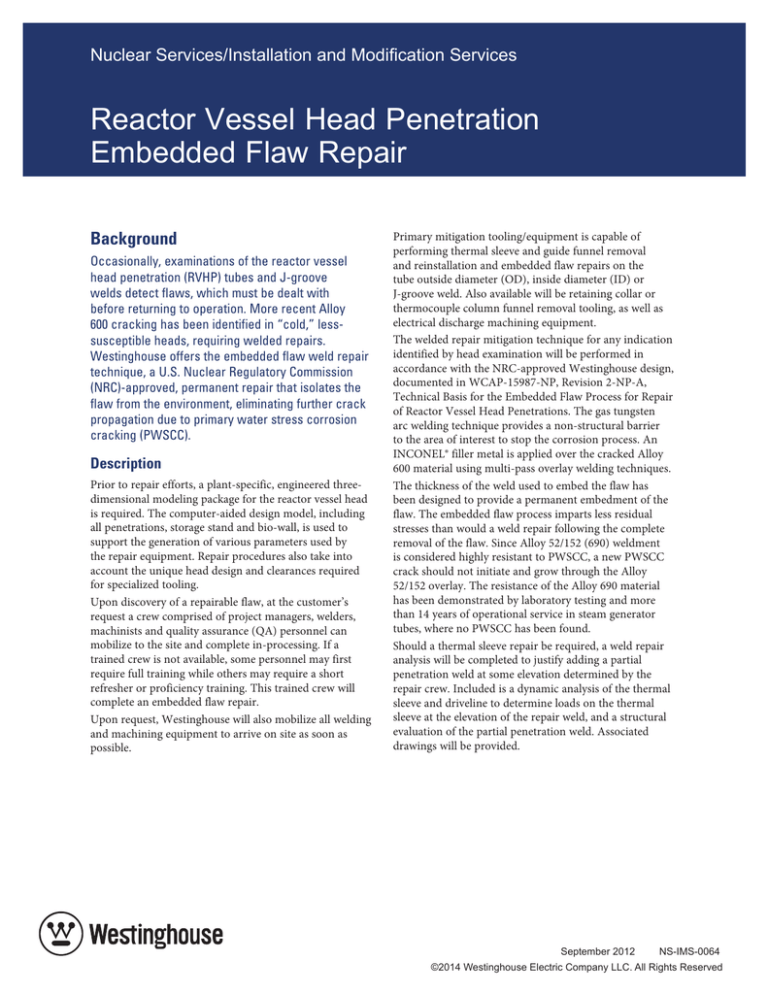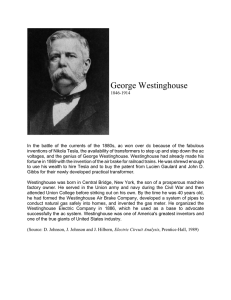
Nuclear Services/Installation and Modification Services
Reactor Vessel Head Penetration
Embedded Flaw Repair
Background
Occasionally, examinations of the reactor vessel
head penetration (RVHP) tubes and J-groove
welds detect flaws, which must be dealt with
before returning to operation. More recent Alloy
600 cracking has been identified in “cold,” lesssusceptible heads, requiring welded repairs.
Westinghouse offers the embedded flaw weld repair
technique, a U.S. Nuclear Regulatory Commission
(NRC)-approved, permanent repair that isolates the
flaw from the environment, eliminating further crack
propagation due to primary water stress corrosion
cracking (PWSCC).
Description
Prior to repair efforts, a plant-specific, engineered threedimensional modeling package for the reactor vessel head
is required. The computer-aided design model, including
all penetrations, storage stand and bio-wall, is used to
support the generation of various parameters used by
the repair equipment. Repair procedures also take into
account the unique head design and clearances required
for specialized tooling.
Upon discovery of a repairable flaw, at the customer’s
request a crew comprised of project managers, welders,
machinists and quality assurance (QA) personnel can
mobilize to the site and complete in-processing. If a
trained crew is not available, some personnel may first
require full training while others may require a short
refresher or proficiency training. This trained crew will
complete an embedded flaw repair.
Upon request, Westinghouse will also mobilize all welding
and machining equipment to arrive on site as soon as
possible.
Primary mitigation tooling/equipment is capable of
performing thermal sleeve and guide funnel removal
and reinstallation and embedded flaw repairs on the
tube outside diameter (OD), inside diameter (ID) or
J-groove weld. Also available will be retaining collar or
thermocouple column funnel removal tooling, as well as
electrical discharge machining equipment.
The welded repair mitigation technique for any indication
identified by head examination will be performed in
accordance with the NRC-approved Westinghouse design,
documented in WCAP-15987-NP, Revision 2-NP-A,
Technical Basis for the Embedded Flaw Process for Repair
of Reactor Vessel Head Penetrations. The gas tungsten
arc welding technique provides a non-structural barrier
to the area of interest to stop the corrosion process. An
INCONEL® filler metal is applied over the cracked Alloy
600 material using multi-pass overlay welding techniques.
The thickness of the weld used to embed the flaw has
been designed to provide a permanent embedment of the
flaw. The embedded flaw process imparts less residual
stresses than would a weld repair following the complete
removal of the flaw. Since Alloy 52/152 (690) weldment
is considered highly resistant to PWSCC, a new PWSCC
crack should not initiate and grow through the Alloy
52/152 overlay. The resistance of the Alloy 690 material
has been demonstrated by laboratory testing and more
than 14 years of operational service in steam generator
tubes, where no PWSCC has been found.
Should a thermal sleeve repair be required, a weld repair
analysis will be completed to justify adding a partial
penetration weld at some elevation determined by the
repair crew. Included is a dynamic analysis of the thermal
sleeve and driveline to determine loads on the thermal
sleeve at the elevation of the repair weld, and a structural
evaluation of the partial penetration weld. Associated
drawings will be provided.
September 2012
NS-IMS-0064
©2014 Westinghouse Electric Company LLC. All Rights Reserved
If thermal sleeves or guide funnels must be removed
to facilitate head penetration repairs, or if excessive
thermal sleeve wear is found, Westinghouse can supply
replacement thermal sleeves and hardware, as well as guide
funnels. The replacement hardware will be installed to
replace the removed sections of the original equipment.
After the repair, Westinghouse will use a portion of its
reactor vessel head inspection crew already onsite to
perform the post-repair ultrasonic testing exam.
Westinghouse, which provides technical skill sets for
welding and machining functions, has a robust quality
assurance (QA) program. Having fully integrated QA
programs and processes, Westinghouse can effectively
support its customers.
Buttering (182)
RV head
Penetration
tube (600)
J-weld (82/182)
Cladding (308)
Thermal
sleeve
Typical RVHP
Outside diameter/J-welder
Benefits
Teaming with Westinghouse reduces overall risk and
effect on the plant’s critical path. RVHP repairs require
many specialized tools, qualified resources, and significant
training and preparation time to execute, as well as
up-front engineering and licensing efforts.
Westinghouse has fully qualified and proven welding
processes and supporting documentation and procedures
to support the RVHP efforts. The company provides
an integrated project experience by coordinating its
engineering, field and installation, and inspection
organizations.
Furthermore, unlike other repair methods, the
Westinghouse embedded flaw repair is permanent. The
generic relief request is documented in WCAP-15987-NP,
Revision 2-NP-A. A plant’s reference of this generic relief
request has already been approved for multiple in-service
plants.
Experience
Westinghouse has completed over 40 RVHP repairs since
1997, with 80 percent of those repairs being on the OD or
J-weld. In addition, nearly 120 thermal sleeves have been
removed and/or replaced. Services have been successfully
provided on a planned and emergent basis.
Inside diameter end effector
INCONEL is a trademark of the Special Metals Corporation
group of companies
Westinghouse Electric Company
1000 Westinghouse Drive
Cranberry Township, PA 16066
www.westinghousenuclear.com


